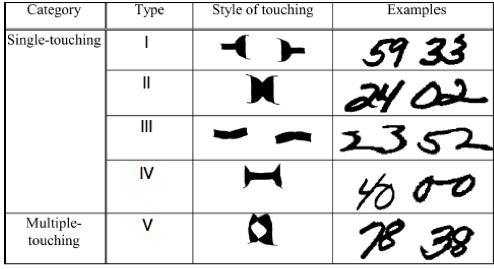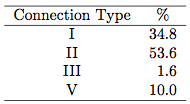- It connects only digits produced by one writer. The information about the writer is provided in NIST SD19. Fifty different writers were considered.
- The reference axis along which the digits slide is the center line.


Synthetic Data for the Segmentation-free Approach
| Length/Classes | Samples | Authors from NIST | Purpose |
| 2-digit (100 classes) | 161,563
53,907 55,091 |
1000-1599
1600-1799 1800-1999 |
Training
Validation Testing |
| 3-digit (1000 classes) | 1,448,680
484,346 491,749 |
1000-1599
1600-1799 1800-1999 |
Training
Validation Testing |
| 4-digit * | 100,000
20,000 20,000 |
1000-1599
1600-1799 1800-1999 |
Training
Validation Testing |
*The goal of 4-digit strings was to have data to train a classifier to predict the size of the numerical string (1,2,3, or 4 digits)
The architectures of the Convolutional Neural Network classifiers used in [4] are also available (based on the Caffe Framework)
How to obtain access to the images
Both Touching Digit (TP) database and Synthetic data for the segmentation-free approach may be used for non-commercial research provided you acknowledge the source of the image by citing the following papers in publications about your research:
- F. C. Ribas, L. S. Oliveira, A. S. Britto Jr, and R. Sabourin. Handwritten Digit Segmentation: A Comparative Study, International Journal of Document Analysis and Recognition, 16(2):127-137, 2013.
- A. Hochuli, L. S. Oliveira, A. S. Britto Jr, and R. Sabourin. Handwritten Digits Segmentation: Is it still necessary? Pattern Recognition, 78:1-11, 2018.
Click here to download the datasets
References
[1] L. S. Oliveira, A. S. Britto Jr, and R. Sabourin. A synthetic database to assess segmentation algorithms. In 8th International Conference on Document Analysis and Recognition, pages 207– 211, 2005
[2] Y. K. Chen and J. F. Wang. Segmentation of single- or multiple-touching handwritten numeral string using background and foreground analysis. IEEE Trans. on Pattern Analysis and Machine Intelligence, 22(11):1304–1317, 2000.
[3] F. C. Ribas, L. S. Oliveira, A. S. Britto Jr, and R. Sabourin. Handwritten Digit Segmentation: A Comparative Study, International Journal of Document Analysis and Recognition, 16(2):127-137, 2013 .
[4] A. Hochuli, L. S. Oliveira, A. S. Britto Jr, and R. Sabourin. Handwritten Digits Segmentation: Is it still necessary? Pattern Recognition, 78:1-11, 2018.
[5] A. Hochuli, L. S. Oliveira, A. S. Britto Jr, and R. Sabourin. Segmentation-Free Approaches for Handwritten Numerical String Recognition, Int. Joint Conference on Neural Networks (IJCNN), 2018.
![]() This database is licensed under a Creative Commons Attribution 4.0 International License.
This database is licensed under a Creative Commons Attribution 4.0 International License.
